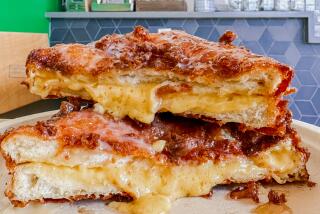Precious Minerals
Without it, our nerves would misfire, our muscles would cramp and our blood would thicken. Of course, most Americans eat so much more salt than we need that the chance of suffering from a lack of it is close to nil. In fact, the trend today is toward more salt--more kinds, colors and origins.
All salts come from the sea, though some of them from ancient, dried-up seas that today are trapped underground. The salt mined from these underground deposits is called rock salt. Ordinary table salt is a ground and refined rock salt with the addition of an anti-caking agent and, sometimes, iodine (a trace element that prevents goiter). Kosher salt is a refined rock salt without additives, and it is commonly used in restaurants because it has none of the bitter metallic flavor of ordinary table salt.
Sea salt is not rock salt. It comes directly from the sea, often from shallow pools along the coastline where the water evaporates and leaves large-grained crystals. The sea salts from Brittany and Normandy, with their subtly sweet taste of pristine oceans, have been the darlings of chefs for decades, yet lately salt fanatics are talking about salt sources as distant as South Africa, Sicily and South Korea.
Many of these sea salts now retail for more than $50 per pound, begging the question: Are they really worth the price? You have to be suspicious when you read the back labels and find stories like the one about an ancient ocean trapped under Peru feeding a spring 10,000 feet high in the Andes, which evaporates into terraced pools located in the Sacred Valley of the Incas. Talk about romanticizing sodium chloride! Or how about the red and black Hawaiian sea salts that incorporate the color and taste of red clay and prehistoric beds of lava? It seems laughable that after thousands of years of trying to make salt white, connoisseurs now pay extra for colors.
In the highfalutin food world, nothing today is as trendy as salt. Like cold-pressed extra-virgin olive oils were in the 1980s, sea salts are all the rage, and gourmets are giddy about the nuances in Celtic gray salt, Indian black salt, Danish smoked salt and many others. For the ultimate cachet, it is hard to beat fleur de sel. This is the “flower of salt,” created when conditions are just right in the checkerboard of pools on France’s Atlantic coast. If the wind blows steadily and the sun beats hot on the water, delicate flakes of salt bloom along the surface. Years ago, salt farmers broke through the network of fleur de sel because it slowed the evaporation of the brine below, but today they carefully skim off the moist, glittering crystals and sell them for almost twice the price of most other sea salts.
I must admit that I am smitten by the taste of pure sea salts. I keep a few kinds in my kitchen cabinet and sprinkle a pinch on my food just as I am getting ready to serve it. The tiny bursts of crystallized saline on salads or roasted meats have an infinitely better quality than ordinary salt, or even kosher salt. But when you get right down to the chemistry, it is startling how little difference there is between them. Ordinary salt is 99% sodium chloride. Sea salt is 99.99% sodium chloride. And the difference between sea salts of all kinds amounts to about .01 of a percent. So I guess the proverbial drop in the bucket is worth more than the bucket and everything else inside.
*
Roasted Rack of Lamb with Rosemary, Shallots and Sea Salt
(Serves 4 )
2 teaspoons balsamic vinegar
1/2 teaspoon sea salt
2 tablespoons extra-virgin olive oil
1 tablespoon finely chopped fresh rosemary
1 tablespoon finely chopped shallots
2 teaspoons Dijon mustard
1/2 teaspoon freshly ground black pepper
2 frenched, trimmed racks of lamb, each about 1 pound and 7 to 8 ribs
In a medium bowl, combine the balsamic vinegar with 1/4 teaspoon of sea salt. Whisk to dissolve the salt. Add the oil, rosemary, shallots, mustard and pepper. Whisk to create a smooth paste. Evenly cover the lamb meat on both sides with the paste.
Set a large skillet over high heat. When the skillet is very hot, sear both racks of lamb, fat side down, until browned, 2 to 3 minutes. Turn the racks over and put the pan in a 375-degree oven. Roast to the desired doneness, 15 to 20 minutes for medium-rare. Transfer the racks to a cutting board; allow to rest for about 3 minutes. Cut into chops. Season with the remaining 1/4 teaspoon of sea salt, or more to taste. Serve warm.
More to Read
Eat your way across L.A.
Get our weekly Tasting Notes newsletter for reviews, news and more.
You may occasionally receive promotional content from the Los Angeles Times.










